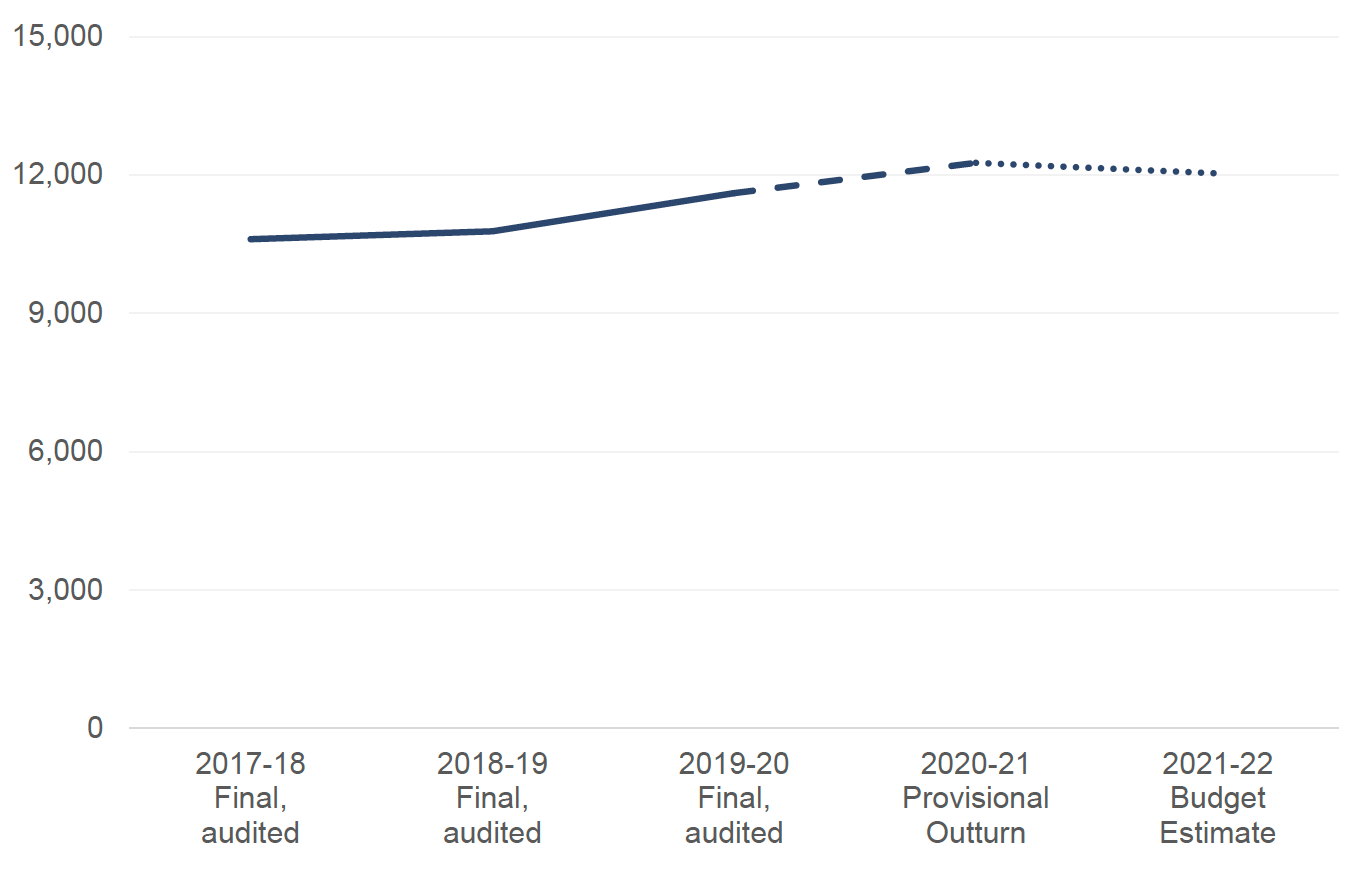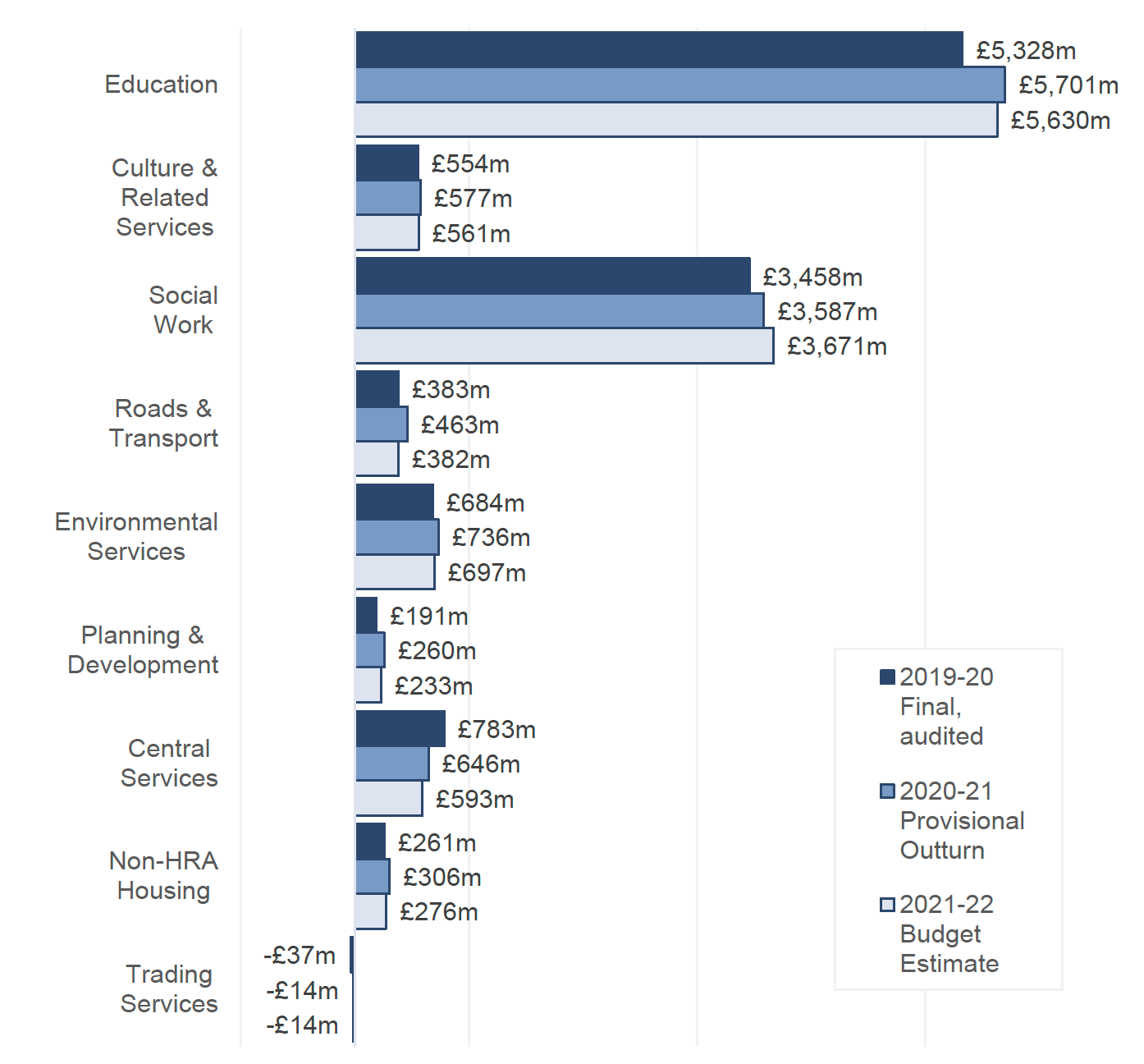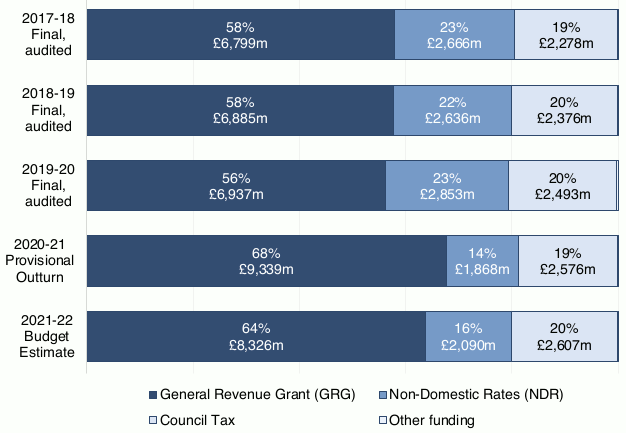Local Government 2020-21 Provisional Outturn and 2021-22 Budget Estimates
This publication summarises the 2020-21 provisional outturn and 2021-22 budget estimates for revenue and capital services provided by Scottish local authorities.
This document is part of a collection
Revenue Expenditure
Revenue expenditure is the cost of delivering services each year and includes both service operating costs and overheads. These costs might include salaries, rent, building maintenance, supplies and services. The benefits from revenue expenditure are mainly received within the financial year.
Net revenue expenditure is the element of revenue expenditure funded by general funding or reserves. It is calculated as gross expenditure on services minus service income[1]. Net revenue expenditure is therefore directly influenced by the amount of service income received, i.e. an increase in service income will reduce net revenue expenditure, and a decrease in service income will increase net revenue expenditure. Where service income is greater than gross service expenditure, a service would have a negative net revenue expenditure, i.e. net income. Individual local authority level figures can also be affected by large, one-off payments in any year, for example Equal Pay back-pay settlement expenditure.
The Revenue POBE collects net revenue expenditure for all General Fund services only[2]. It should also be noted that for the purposes of the Revenue POBE return and this publication, Trading Services includes amounts relating to Harbour Accounts. These are separate accounts and reserve funds specifically for harbour undertakings held by Orkney Islands and Shetland Islands councils only.
Local authorities have reported provisional outturn net revenue expenditure of £12,261 million in 2020-21, and have budgeted net revenue expenditure of £12,031 million for 2021-22. As seen in Figure 1, the 2020-21 provisional outturn has increased from the 2019-20 final, audited net revenue expenditure – this will, at least in part, reflect both increased expenditure and reduced service income due to the Covid-19 pandemic. The budget estimate for 2021-22 has then decreased from the 2020-21 provisional outturn – this may indicate local authorities budgeting for a reduced impact of Covid-19 restrictions on expenditure and income.
Local authorities were asked to provide figures for additional gross expenditure directly incurred by Covid-19 in order to give some indication of the impact of Covid-19 on local authorities’ expenditure. Local authorities reported a provisional outturn figure for 2020-21 of £759 million and a budget estimate for 2021-22 of £296 million. This is in line with the trend seen in Figure 1, where budget estimates look to reflect a reduced impact from Covid-19. Please note that these are gross figures and therefore do not take account of any service specific Covid-19 funding that local authorities may have received in 2020-21 or 2021-22.

Source: POBE 2021 Return, LFR 00
Figure 2 provides a summary of the 2020-21 provisional outturn and 2021-22 budget estimate for net revenue expenditure against the final, audited net revenue expenditure from 2019-20 by service. In line with the general trend seen in Figure 1, net revenue expenditure for most services has seen an increase in provisional outturn followed by a decreased budget estimate.
Education has the highest net revenue expenditure, with provisional outturn of £5,701 million in 2020-21, and a budget estimate for 2021-22 of £5,630 million. This is in line with the overall trend in net revenue expenditure as shown in Figure 1.
Social Work has the second highest net revenue expenditure, with local authorities reporting provisional outturn of £3,587 million and budget estimate of £3,671 million. This increase in both provisional outturn and budget estimate differs from the overall trend, but was seen across the majority of local authorities. Local authorities reported a variety of reasons for the increase in Social Work budget estimates, including increased demand due to demographic changes and increased funding.
In 2019-20 Central Services net revenue expenditure included a £437 million equal pay settlement for Glasgow City Council, making that figure notably higher than in previous years. However, provisional outturn and budget estimates remain above the level seen prior to 2019-20 because, as noted in the Introduction section on page 2, local authorities were required to record any non-service specific or unallocated Covid-19 expenditure and income against this service.

Source: POBE 2021 Return, LFR 00
Notes
’Roads & Transport’ includes Road Bridges.
Local authorities also incur some revenue expenditure and income that is not attributable to specific services, such as interest paid or received, or statutory repayment of debts. As shown in Table 1, local authorities’ provisional outturn and budget estimates for other expenditure and income is £1,083 million and £1,108 million respectively.
General funding principally consists of the General Revenue Grant (GRG) and local taxation, specifically Non-Domestic Rates (NDR) and Council Tax. Local authorities have reported provisional general funding of £13,804 million in 2020-21, and have budgeted for general funding of £13,042 million in 2021-22. Figure 3 shows the split of General Funding by source.
GRG is grant paid to local authorities by the Scottish Government and includes monies from the UK Government payable to a local authority. The Scottish Government guarantees the combined sum of GRG and NDR funding for local authorities in each financial year. In 2020-21 and 2021-22, there was a significant reduction in NDR, due to rates relief to support various sectors during the Covid-19 pandemic, which has been matched by an increase in GRG. The GRG figures for both 2020-21 and 2021-22 also include significant amounts of Covid-19 specific funding for local authorities.
More information on the process to determine local government funding from the Scottish Government is available in the Local Government Funding: Process Overview publication; and detailed funding figures per local authority are available in the latest Local Government Finance Circulars.

Source: POBE 2021 Return, LFR A0
Notes
‘Other funding’ includes government grants paid to joint boards and income received through NDR TIF and BRIS schemes. As this category amounts to less than 1% of total general funding in each year shown, this category is not visible in the chart – the figures for this category can be found in the ‘POBE 2021 – Tables’ supporting Excel file.
The 2018-19 GRG figure includes £10 million for Teacher’s Pay that was actually paid to local authorities as part of the 2019-20 GRG. Figures for these years therefore differ to those in the corresponding Finance Circular.
A surplus occurs when a local authority’s net revenue expenditure is less than the amount of general funding received. A surplus is added to a local authority’s reserves and carried forward to the next year. A deficit occurs when a local authority’s net revenue expenditure is more than the amount of general funding received. Any deficit must be met from a local authority’s reserves. Table 1 shows the surplus / deficit, in addition to the total movement in general fund reserves.
| 2019-20 Final, audited | 2020-21 Provisional Outturn | 2021-22 Budget Estimates | |
|---|---|---|---|
| Balance at 1 April | 1,495 | 1,585 | 1,955 |
| Less: Net Revenue Expenditure | 11,610 | 12,261 | 12,031 |
| Add: Other Income (+) and Expenditure (-) | -1,145 | -1,083 | -1,108 |
| Add: General Funding | 12,323 | 13,804 | 13,042 |
| Add: Total Surplus (+) or Deficit (-) on provision of services | -432 | 460 | -97 |
| Add: Movements between Reserves | 472 | -59 | 18 |
| Less: Increase (+) or decrease (-) in IFRS 9 unrealised gains | -49 | 29 | -60 |
| Balance at 31 March | 1,584 | 1,957 | 1,935 |
Source: POBE 2021 Return, LFR A0, LFR 23
Notes
General Fund figures include amounts relating to Harbour Accounts for Orkney and Shetland.
‘Balance at 1 April’ excludes amounts relating to unrealised gains at 31 March in the prior year. These have been included in revenue reserves applying under International Financial Reporting Standard (IFRS) 9 which specifies how local authorities should classify and measure financial instruments.
For ‘Movements between Reserves’, net movements in are shown as a positive; net movements out are shown as a negative.
Figures for 2017-18 and 2018-19 are provided in the ‘POBE 2021 – Tables’ supporting Excel file.
Across all local authorities, the provisional outturn figures give a surplus of £460 million, and an increase in the General Fund balance at 31 March to £1,957 million, in 2020-21. This significant surplus, and associated increase in General Fund balance, is likely driven by non-recurring Covid-19 funding of £1,254 million for local authorities which was confirmed to be paid via GRG on 18 March 2021. Whilst this funding has been included in local authorities’ GRG figures, due to the timing of the calculation of provisional outturn figures, the associated expenditure may not be fully reflected in the net revenue expenditure figures provided, giving rise to this surplus.
Local authorities’ provisional outturn and budget estimate figures give a deficit of £97 million, and a decrease in General Fund balance at 31 March to £1,935 million, in 2021-22.
Contact
Email: lgfstats@gov.scot
There is a problem
Thanks for your feedback